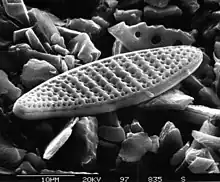Fragilariopsis kerguelensis
Fragilariopsis kerguelensis,[1] is a pennate diatom native to the Southern Ocean. It has been characterized as "the most abundant diatom in the Antarctic Seas".[2]
| Fragilariopsis kerguelensis | |
|---|---|
 | |
| Scientific classification | |
| Domain: | Eukaryota |
| Clade: | Diaphoretickes |
| Clade: | SAR |
| Clade: | Stramenopiles |
| Phylum: | Gyrista |
| Subphylum: | Ochrophytina |
| Class: | Bacillariophyceae |
| Order: | Bacillariales |
| Family: | Bacillariaceae |
| Genus: | Fragilariopsis |
| Species: | F. kerguelensis |
| Binomial name | |
| Fragilariopsis kerguelensis (O'Meara) Hustedt | |
| Synonyms | |
| |
Description
Fragilariopsis kerguelensis is a unicellular, phototrophic, microalga with a range in size of 10 - 80 μm.[3] It is encased in a heavily silicified cell wall, called the frustule, and is identified by its unique theca, raphe and striations, which distinguish it from other diatoms.[4] They are native to pelagic environments of the Southern Ocean within a temperature range of -1° to 18° C.[5] F. kerguelensis is known to form community chains that consist of 20-100 cells and can be up to 300 μm long.[6]
Use as a paleoceanographic proxy
Fragilariopsis kerguelensis is well preserved in the fossil record and commonly referenced as a paleoceanographic or paleoclimatic proxy. F. kerguelensis comprises the largest deposit of biogenic silica in the world (~75%) despite only accounting for 20% of global production.[5][7] It is an open water species and is found in its highest abundance between the Antarctic Circumpolar Current and the Subtropical Front.[8] This, along with its tendency to increase valve size near polar fronts, makes F. kerguelensis an ideal indicator of paleoclimate polar front or low-carbon, high-silica exporting regimes.[9][10] Modern assemblages with F. kerguelensis can be used to calculate past sea surface temperature through the use of transfer functions.[5]
References
- O'Meara, E (1877). "the diatomaceous gatherings made at Kerguelen's Land". Journal of the Linnean Society, Botany (15): 55–59.
- Hart, T.J (1942). "Phytoplankton periodicity in Antarctic surface waters". Discovery Rep.
- Smetacek, V (1999). "Diatoms and the ocean carbon cycle". Protist. 150 (1): 25–32. doi:10.1016/s1434-4610(99)70006-4. PMID 10724516.
- "Fragilariopsis kerguelensis (O'Meara) Hustedt, 1952". World Register of Marine Species. World Register of Marine Species.
- Zielinski, U; Gersonde, R (1997). "Diatom distribution in Southern Ocean surface sediments (Atlantic sector): Implications for paleoenvironmental reconstructions". Palaeogeography, Palaeoclimatology, Palaeoecology. 129 (3–4): 213–250. Bibcode:1997PPP...129..213Z. doi:10.1016/s0031-0182(96)00130-7.
- Smetacek, V; Assmy, P; Henjes, J (2004). "The role of grazing in structuring Southern Ocean pelagic ecosystems and biogeochemical cycles". Antarctic Science. 16 (4): 541–558. Bibcode:2004AntSc..16..541S. doi:10.1017/s0954102004002317. S2CID 131176101.
- Verity, P.G; Smetacek, V (1996). "Organism life cycles, predation, and the structure of marine pelagic ecosystems". Marine Ecology Progress Series. 130 (1): 231–250. Bibcode:1996MEPS..130..277V. doi:10.3354/meps130277.
- Crosta, X; Romero, O; Armand, L.K; Pichon, J.J (2005). "The biogeography of major diatom taxa in Southern Ocean sediments: 2. Open ocean related species". Palaeogeography, Palaeoclimatology, Palaeoecology. 223 (1): 6–92. Bibcode:2005PPP...223...66C. doi:10.1016/j.palaeo.2005.03.028.
- Cortese, G; Gersonde, R (2007). "Morphometric variability in the diatom Fragilariopsis kerguelensis: Implications for Southern Ocean paleoceanography" (PDF). Earth Planet. Sci. Lett. 257 (3–4): 526–544. Bibcode:2007E&PSL.257..526C. doi:10.1016/j.epsl.2007.03.021.
- "Profile: Fragilariopsis kerguelensis - Biota - Confluence". SOKI Wiki. Antarctic Climate and Ecosystems Co-operative Research Centre.